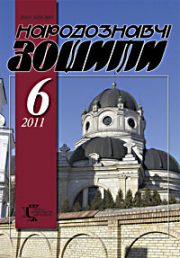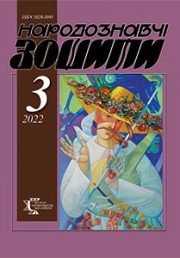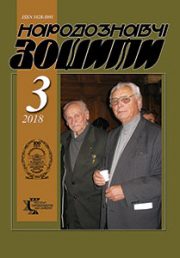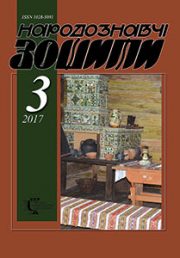The Ethnology Notebooks. 2020. № 4 (154),759—769
UDK 7:2.7.01(477)
DOI https://doi.org/10.15407/nz2020.04.759
HERII Oksana
- ORCID ID: https://orcid.org/0000-0002-8383-227X
- Ph. D in Art Studies,
- Senior Researcher at the Art Studies Department,
- The Institute of Ethnology of the National
- Academy of Sciences of Ukraine,
- 15, Svobody Avenue, 79000, Lviv, Ukraine.
- Contacts: e-mail: oheriy@ukr.net
Abstract. Introduction. In the last quarter of the 19th century in the Galicia artistic environment there were more and more calls to study the architecture of the native people, to search for the characteristic features of the architectural expressiveness of Greek Catholic churches. Within the romantic direction of historicism, the Neo-Byzantine style was attractive and eloquent for Ukrainians, as it directed the viewer to think about the origins of Christian culture in Ukraine.
Problem statement. A new interest in Byzantine art (after centuries of oblivion) began in the late first third of the 19th century. It arose almost in parallel in Western Europe (Italy, Germany, England, Austria), and in the Russian Empire. However, the development of the Byzantine Revival style in the architecture of both of these centers was different, because it depended on different models chosen to follow, and on different ideas that stimulated the study of Byzantine architecture.
Methods. The article will highlight the characteristics of Western European and Russian development of the Neo-Byzantine style and compare them with the features of the church architectural design in Galicia in the late nineteenth century.
Results. Consideration of the architectural works by Sylvestr Gavrishkevych, Vasyl Nagirnyj, Julian Zakharevych testifies the prevalence of the basic principles of composition and decor, derived from the Western European version of style development. Also Vasyl Nagirnyj deliberately included in his projects some elements observed by him in the St. Volodymyr Cathedral in Kyiv. The constructive interpretation of the Neo-Byzantine style used by some European architects found a response in the projects of Lviv architects too.
Сonclusions. The Byzantine Revivalmovementin the architecture of the 19th century in Galician churches was the first step in the searching for the external architectural forms of the Ukrainians self-identification. Each architectural monument is an important witness to the stage of development of national culture, and therefore requires careful treatment and preservation.
Keywords: sacred architecture, Neo-Byzantine style, dome, tetraconch, church building.
Received 26.05.2020
REFERENCES
- Bobosh, H. (2005). The Formation of the Brick Church Architecture in Galicia in the Late 18th — Early 20th Century (examples of the Lviv diocese). (Dr. arch. diss. abstr.). Lviv [in Ukrainian].
- (1880). Filip Pokutynski — wspomnienie posmiertne. Czasopismo Techniczne, 1 [in Polish].
- Wdowiszewski, J. (1881). Malarstwo dekoratywne ze szczegolnem uwzglednieniem miejscowych stosunkow. Czasopismo Techniczne, 7 [in Polish].
- (1880). Czasopismo Techniczne, 1 [in Polish].
- Bobosh, H. (2002). Architectural and Stylistic Features of the Brick Churches of Galicia in the Late 18th — Early 20th Centuries. The Ethnology Notebooks, 1—2, 88—99 [in Ukrainian].
- Linda, S., & Biruliov, Yu. (Ed.). (2008). Architecture of Historicism. The Lviv Architecture: Time and Styles (Pp. 240—310). Lviv: Center of Europe [in Ukrainian].
- Hnidec’, R. (2015). The National Identity of Architecture of Ukrainian Churches in the Tradition and Innovation of Their Expression. Bulletin of Lviv Polytechnic National University: Architecture, 836, 168—175 [in Ukrainian].
- Rakochyj, Ya., & Borys, A. (2015). The Ontology of Creation of Ukrainian National Attributes in the Sacred Architecture of Galicia. Bulletin of Lviv Polytechnic National University: Architecture, 816, 247—254 [in Ukrainian].
- Lew, Kh., Slobodyan, V. & Filevych, N. (2013). 100 Churches of the Nahirny. Part one. Churches of Vasyl Nahirny. Lviv: Center of Europe [in Ukrainian].
- Willard, A.R. (1902). History of Modern Italian Art. London: Longmans, Green and Co.
- Kislykh, T. (2013). Byzantine Style in the Architecture of European Countries of the Late 19th — Early 20th century. The Problems of Style Evolution and Typology of Architecture (Pp. 71—79). St. Petersburg [in Russian].
- Bullen, J.B. (2003). Byzantium Rediscovered. London: Phaidon Press Ltd.
- Krasny, Р. (2004). Kaplica Domu Inwalidow Wojskowych. Koscioly i klasztory rzymskokatolickie dawnego wojewodstwa Ruskiego, 12, 67—76 [in Polish].
- Herii, O. (2018). Churches of Galicia with Decorative Angular Pylons at the End of the 19th Century: the Genesis of the Form. The Ethnology Notebooks, 6 (144), 1596—1602 [in Ukrainian].
- Bobosh, H. (2000). Trails of Vasyl Nahirny’s life and work (1848—1921). The Ethnology Notebooks, 2, 347—355 [in Ukrainian].
- Nahirny, V. (1905). A Few Words in the Case of Church Buildings. Dilo, 225 [in Ukrainian].
- Nahirny, V. (1935). From my Memories. Lviv [in Ukrainian].
- Aleksandrovskyj, I. (1897). Cathedral of St. Volodymyr in Kyiv. Kyiv [in Ukrainian].
- Borisova, E. (1979). Russian Architecture of the Second Half of the 19th Century. Moscow: Nauka [in Russian].
- Stasov, V. (1952). 25 years of Russian art: Our architecture. Selected Works (Vol. 2, pp. 510—524). Moscow [in Russian].
- Savelyev, Yu. (2005). Byzantine Style in Russian Architecture: the second half of the 19th — the beginning of the 20th century. St. Petersburg [in Russian].
- (1860). Architectural Bulletin, 4. St. Petersburg [in Russian].
- Simonova, О. (2010). Yuriy Rostislavovich Savelyev. Byzantine Style in Russian Architecture: Criticism of the book. Bulletin of the Russian Christian Humanitarian Academy, 11, 4, 261—272 [in Russian].
- Ustyianovych, K. (1902). Churches of Nahirny. Dilo, 262 [in Ukrainian].
- Nahirny, V. (1890). Something about Church Building. Bat’kivshchyna, 28 [in Ukrainian].
- Hrushevskyj, М. (1907). Our Sins. Literary and Scientific Bulletin, 38, 5, 324—330 [in Ukrainian].
- Holubec’, М., & Krypjakevych, I. (Ed.). Seekers of new roads. The History of Ukrainian Culture (Pp. 562—586). Kyiv: Lybid’ [in Ukrainian].
- Paszkiewicz, Р. (1991). Pod berіem Romanowow: sztuka rosyjska w Warszawie, 1815—1915. Warszawa: Instytut Sztuki PAN [in Polish].
- Vujcyk, V., Ivasejko, S. & Slobodyan, V. (2001). Ukrainian churches of Brody district (Vol. 1). Lviv: Misioner [in Ukrainian].
- Krasny, Р., & Bulsza, W. (Ed.). (2001). O kilku prуbach modernizacji architektury cerkiewnej w Galicji okoіo roku 1900. In W. Bulsza. Ars graeca — ars latina. Studia dedykowane Annie Rуїyckiej Bryzek (Pp. 245—272). Krakow [in Polish].







